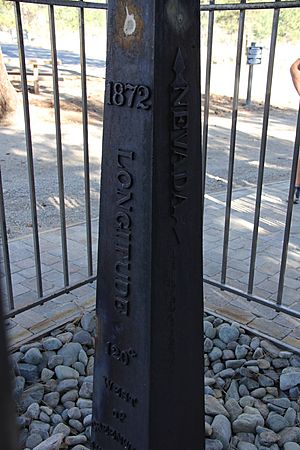Alexey W. Von Schmidt facts for kids
Alexei Waldemar Von Schmidt (1821–1906) was a brilliant engineer and surveyor. He was born in Russia and moved to the United States when he was six. In 1849, he traveled to California from New York City during the exciting California Gold Rush. Instead of digging for gold, he used his skills to find steady work as an engineer and surveyor.
Quick facts for kids Von Schmidt State Boundary Monument |
|
|---|---|

Von Schmidt with a State Boundary Monument
|
|
| Location | near Needles, California |
| Built | 1873 |
| Architect | Von Schmidt |
| Designated | April 26, 1973. |
| Reference no. | 859 |
| Lua error in Module:Location_map at line 420: attempt to index field 'wikibase' (a nil value). | |
Contents
Alexei W. Von Schmidt's Amazing Work
Alexei W. Von Schmidt quickly found important jobs in California. In 1853, he surveyed land in Contra Costa County, California, Rancho San Miguel, and Yuba County. Later, in 1855, he surveyed land near Mono Lake, and his work expanded all the way down to Yosemite.
Building San Francisco
Von Schmidt worked on many projects for the City of San Francisco. One of his biggest jobs was helping to build San Francisco's first dam and aqueduct system. An aqueduct is like a giant pipe or channel that carries drinking water. He also became a key engineer for the famous San Francisco cable car system, which still runs today!
Blasting Blossom Rock
In 1870, Von Schmidt led a huge project to remove a dangerous underwater rock in San Francisco Bay called Blossom Rock. This rock was a hazard to ships. The plan involved months of careful work and testing. They used a massive 23 tons of black powder for the explosion. Thousands of people watched as the rock was successfully blown up.
Mapping State Borders
In 1872, Von Schmidt began a two-year project to survey the border of California. This was a very important and challenging task. He passed away on May 18, 1906, in San Francisco. He even survived the big 1906 San Francisco earthquake that happened just a month before he died. Alexei's brother, Alfred Von Schmidt, also came west and had a grape farm in Fresno.
The Von Schmidt State Boundary Monument
The Von Schmidt State Boundary Monument is a special landmark. It was named a California Historic Landmark (No. 859) on April 26, 1973. Alexei W. Von Schmidt built this monument in 1873 in San Bernardino County, California, near Needles, California.
Surveying the California-Nevada Border
In 1872 and 1873, Von Schmidt surveyed the border between California and Nevada/Arizona. The California Historic marker is on Pew Road, about 14 miles north of Needles.
There was a disagreement between Nevada and California about where the border should be. California became a state in 1850 and decided its eastern border would be at 120 degrees west longitude. Between 1855 and 1900, there were six different surveys to find this line, and each one found it in a slightly different spot!
Von Schmidt's Big Challenge
Von Schmidt was chosen to survey the state's border east of the Sierra Nevada mountains. In 1872, he set out with his team using only a compass, a sextant (a tool to measure angles), and dead reckoning (a way to estimate position). His job was to measure and mark the boundary.
Von Schmidt and his crew built stone markers and placed cast iron markers about one mile apart along the border. Many of these markers didn't have strong foundations, so not many are left today.
The Border's True Location
A new survey in 1893 showed that Von Schmidt's line was off by about 1,600 to 1,800 feet to the west of the actual 120-degree line. However, both California and Nevada still recognize Von Schmidt's 1872 survey and the 1893 survey as the state line. Later, the 1893 line was used. The exact location of the California-Nevada border was debated and surveyed many times.
One of the few iron markers that still exists is near Verdi, Nevada. It is called the 1872 California-Nevada State Boundary Marker and is a National Historic Landmark.
Retracing the Steps
In 1976, a surveyor named Bud Uzes retraced Von Schmidt's 1872–1873 journey along California's border near North Tahoe. Bud Uzes even wrote a book called Chaining the Land about the different surveys that defined the California-Nevada boundary.
Marker Details
The marker at the Needles site tells us:
- This boundary monument, a cast iron column built in 1873, shows the southern end of the California-Nevada State boundary. This line was set by A. W. Von Schmidt's survey in 1872–73. Von Schmidt's line was the first official border between California and Nevada. It was slightly off, and the boundary was later corrected to the current line, which is about 3/4 mile to the north.


